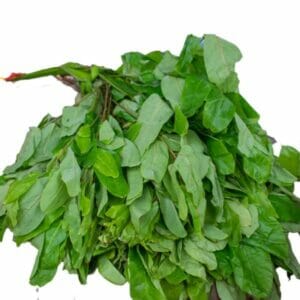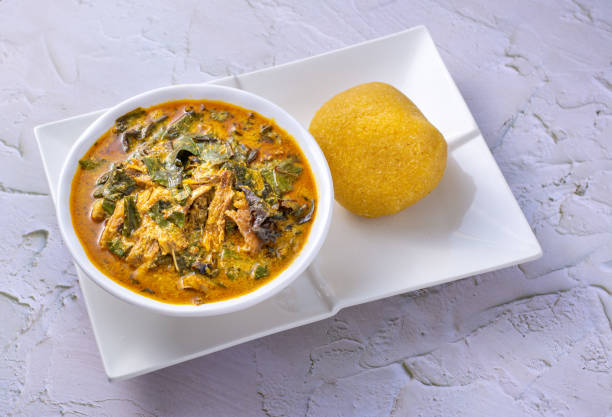Oha soup is a dish native to the Igbo people. So, you must have eaten this dish if you are Igbo or have Igbo friends. The soup isn’t just delicious and easy to prepare, but it is also an affordable soup to prepare.
This is why the Igbos eat oha soup all through the year. It is a soup cooked for everyday lunch, dinner, and special occasions.
The soup derives its name from the leaves used to prepare it, oha leaf. The English name for this leaf is the African Rosewood plant.
Oha leaf, also known as ora leaf, grows all year round. The evergreen nature of the leaf is why the soup is cooked all year long and is affordable.
Besides being the major ingredient in oha soup, oha leaf is highly medicinal. So, the oha tree is considered one of the medicinal trees.
In this article, we’ll look at the nutritional and health benefits of oha leaf and how to cook a delicious pot of oha soup.
Ready?
Nutritional Benefits of Oha Leaf

Oha leaf is an evergreen medicinal plant grown in various regions of Africa. On average, 100 grams of the raw leaf contains approximately:
- Protein: 12 grams
- Moisture content: 90 grams
- Carbohydrate:6 grams
- Calcium: 83 milligrams
- Iron: 8 milligrams
- Zinc: 6 milligrams
- Magnesium: 30 milligrams
- Calorie: 53 Kilocalories
Besides these, the oha leaf is rich in vitamins, antioxidants, and minerals. With this in mind, let’s explore the different health benefits of this medicinal plant.
Prevents Anemia
A person suffering from anaemia has a limited supply of oxygenated haemoglobin or red blood cells. Iron is the primary mineral that forms haemoglobin, and the oha leaf is rich in iron.
Adding oha leaf to your diet automatically increases the body’s iron supply. In return, an increased iron supply encourages haemoglobin production. Dishes containing oha also help in the treatment of anaemia.
Maintains the Movement of the Gastro-Intestinal Tract
The dietary fibre in the oha leaf helps maintain the GI tract’s movement and prevents colon cancer by clearing the gut. These fibres also prevent indigestion, constipation, and other digestion problems or tummy upsets.
If you suffer from regular constipation or indigestion, you should consider adding oha leaf to your meals.
Maintains your Bones and Teeth
Oha leaf is rich in micronutrients such as calcium and magnesium. These micronutrients help in the formation and maintenance of healthy bones and teeth. It also prevents women from suffering from age-related osteoporosis.
Prevents High Blood Pressure
In addition to magnesium, potassium is another micronutrient found in oha leaf. Together, these micronutrients help to maintain stable blood pressure. Magnesium and potassium cause the muscle relaxation of blood vessels.
Sudden hypertension is why you must eat healthily and go for regular check-ups to prevent an increase in your blood pressure. However, regularly adding oha to your meals helps to avoid hypertension.
Stops Frequent Stooling
An increase in bowel movement causes frequent stooling or diarrhoea. Together, zinc and fibre found in the oha leaf reduce the irregular movement of the bowel.
When the irregular bowel movement stops, the frequent stopping will stop.
It Prevents Arthritis
Arthritis occurs when there is joint inflammation. This causes pain and discomfort in the affected joint and makes mobility hard.
Manganese, a micronutrient also found in oha, prevents inflammation of joints. In addition, this micronutrient keeps the joints lubricated and helps form healthy joint cartilages.
Provided the joints are lubricated, there is a slim chance of inflammation. No joint inflammation means no arthritis.
It Helps Regulate the Blood Glucose Level
Interestingly, oha leaf helps to maintain a healthy blood glucose level. Also, because it is low in calories, regular oha leaf consumption doesn’t lead to a calorie build-up in the body.
A build-up of calories in the body leads to an increase in the blood glucose level. People become predisposed to diabetes when their blood glucose level is always high.
Improves the Immune System
Oha leaf is rich in vitamin C and vitamin B6. These vitamins protect the body through their immune-boosting properties.
Studies have also confirmed that the leaf contains antioxidants and phytochemicals, both of which strengthen the immune system.
These natural constituents help the body fight and prevent infections.
Prevents the Formation of Cancer Cells
Antioxidants help to neutralize the effect of free radicals in the body. Free radicals cause the formation of cancer cells.
They do this by causing oxidative stress. This, in return, can lead to the mutation of the DNA of the affected cells.
By neutralizing the actions of free radicals, antioxidants counter its effect. This, in turn, helps to prevent the formation of cancer cells.
Protects Nerve Endings
Nerve endings are the most sensitive part of a nerve. They are also the most sensitive part of nerves.
The vitamin B content in the oha leaf helps to protect the nerve endings. This protects the nerve from nerve-related damages.
The leaf also contains glutamic acid, which benefits the general health of neurotransmitters.
This non-essential amino acid, glutamic acid, helps to prevent brain-related disorders like Parkinson’s disease or schizophrenia.
Used in the Treatment of Malaria
Oha leaf is used locally in the treatment of malaria. The leaf has antimicrobial properties that help fight the malaria parasite.
Helps in the Repair of Body Cells and Torn Tissues
The high protein content in oha soup encourages swift repair and maintenance of body tissues and torn muscles. Cystine is one of the proteins in the oha leaf that helps improve muscle mass.
The lysine found in oha helps grow biological tissues and provides the body with energy. This makes oha leaf ideal for athletes who expend a lot of energy.
Keeps the Skin Youthful
Oha leaf promotes the formation of collagen. Collagen is a protein that helps keep the skin firm and free from wrinkles.
Also, the protein helps form and maintain the structure of other connective tissues in the body. Especially the bone, cartilage, and teeth
Improves Vision
The leaf is rich in vitamins. The most notable of these vitamins is vitamin A. Vitamin A helps to improve vision. In addition, it helps to maintain a clear cornea.
Vitamin A also promotes the general health of the eye and prevents eye defects.
Now that we have a clear picture of how nutritious the oha leaf is, let’s look at how you can prepare a delicious pot of oha soup.
So,
How can you Prepare a Delicious Pot of Oha Soup?
Oha soup is an easy and affordable soup to prepare. One of the perks of this soup is that it always turns right.
It is a traditional Igbo soup. The ingredients and mode of preparation discussed in this article will cover the native way of preparing the soup.
You don’t need to worry about finding these ingredients. Every ingredient used in the preparation of oha soup is evergreen. So, you’ll find them throughout the year.
Ingredients
- Any meat of choice or fish: These will serve as your protein.
- Dried fish: These also add flavour and nutritional benefits to the soup.
- Stockfish: Stockfish is a must in every Igbo soup. There is a particular taste it adds to the soup.
- Powdered crayfish also add flavour to the soup, but you can pass if you’re allergic to them.
- Cow skin (ponmo): These add flavour to the soup and give it a richer appearance.
- Red oil: this is a vital ingredient in most soups.
- Cocoyam or ofor: Cocoyam is the ideal choice, but ofor can serve as a substitute. Either of them acts as a soup thickener. They bind all the ingredients of the soup.
- Freshly cut oha leaf: a necessary ingredient
- Freshly cut uziza leaf (optional): these add flavour. You can leave it out if you wish.
- Seasoning cubes: add them to taste.
- Salt: add to taste.
- Fresh or dry pepper: add to taste.
Steps to Prepare Oha Soup
- Cook and pound the cocoyam till it is smooth.
- Season the meat, ponmo, stockfish, and any other protein being used to taste.
- Steam them together in a pot till the meat is tender.
- Add more water to the pot of boiling meat ( the quantity of water added will depend on the quantity of soup you want to make).
- Cover the pot and let the broth cook for a while.
- Add palm oil to the pot once the broth starts steaming.
- When the broth starts boiling, add the pounded cocoyam or ofor.
- Allow the soup to boil till all the ingredients are properly mixed.
- Add pepper to taste.
- Add the seasoning and salt to taste, and leave the soup to boil.
- If uziza leaves are being used, add them now and allow the soup to cook for a minute.
- Add the oha leaf and let the soup cook for 10 seconds.
- Your soup is ready. Serve with any complement of choice.

Conclusion
Oha soup is a cherished Igbo soup. The soup is prepared from an evergreen leaf called oha. Besides the leaf, the other ingredients are available throughout the year. Also, it is easy to prepare and affordable.
As with all meals, there is more to this dish than its pleasing taste. It is highly nutritious. The oha leaves have both medicinal and nutritional properties.
If you haven’t tasted oha soup before, try it out. Your taste buds will be grateful to you for making it feel good, and your body will be thankful for the positive benefits.



